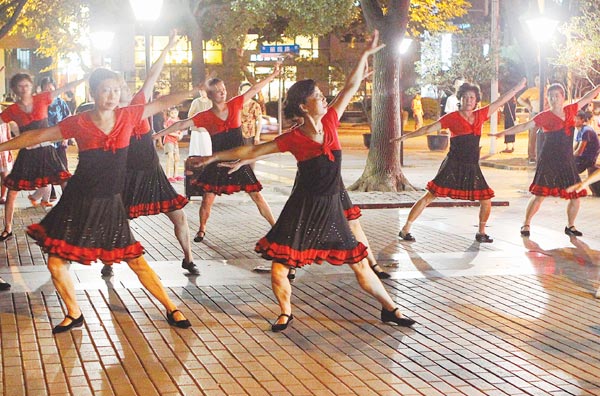

Middle-aged women don identical costumes for their daily dancing session downtown. Gao Erqiang/Shanghai Star
Every day at 7 pm, old-fashioned music fills Hongkou Football Stadium as more than 100 people sway to the beat.
The dancers, mostly women, stand in rows and perform a series of simple but well-timed moves. Two steps forward. Two steps back. Turn around. And clap. They repeat this routine until the music coming through a set of portable loudspeakers stops.
"Hei!", they shout together, as an expression of encouragement and, perhaps triumph.
"Guang chang wu", or public group dancing, has become a popular form of exercise at town squares and stadiums in nearly every Chinese city. The authorities began promoting it in recent years as a way to create more civilized, interactive communities and to encourage more elders to exercise.
Shanghai has extended the opening hours of 66 parks in summer, so more can continue dancing at night, in the open air.
HEALTH AND HAPPINESS
For 72-year-old Qian Mingyue, dancing is the highlight of his daily routine. He organizes a dance group in the city's People's Park, learning his choreography from programs he found online, and now, he teaches other people how to dance.
Since he began dancing two years ago, Qian's waistline has shrunk from 87 cm to 73 cm, and one of his fellow dancers, Wang Xiaofang, 66, has lost 15 kg.
Staying fit is not the only reason group dancing in public has become popular.
Some see it as a chance to expand their social life, kill the boredom of retirement, instead of just sitting at home, cooking and watching TV. Most of the dancers are older empty nesters whose adult children have moved away to lives of their own.
Liang Pinghua, 62, dances in a plaza near her community twice a day — two hours early in the morning and two hours again at night.
She is in charge of all the dancing props such as paper fans, balls, silk scarves, and the music.
"Sometimes I spend my afternoons teaching newcomers," says Liang, whose son is married and has his own apartment. "I feel time passes so quickly, and I am happily occupied."
Liang proudly recalls her granddaughter once saying, "Grandma, you are even busier after you retired."
Yu Hai, a sociology professor at Fudan University, says dancing is good for older people for a variety of reasons.
"The dancers, mostly retired people, no longer have to take care of their children, so they have more leisure time. Through dancing, people can improve their health, expand their social network and develop a positive attitude."
Copyright ©1999-2018
Chinanews.com. All rights reserved.
Reproduction in whole or in part without permission is prohibited.